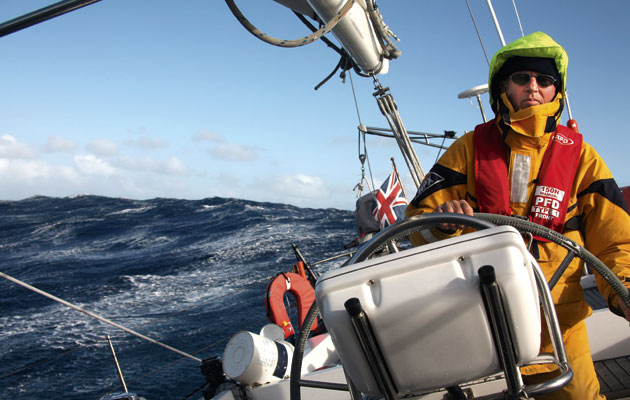What would you do if you were sailing towards cumulonimbus clouds? James Stevens answers your questions of seamanship
You are sailing towards cumulonimbus clouds, what should you do?
James Stevens answers your questions of seamanship
Question:
Vikki purchased her 10m cruiser racer, Meridian, last year.
She is an experienced dinghy sailor and has entered a few yacht races but today she is on a cruising holiday to the West Country with two friends.
She has taken the RYA shore-based navigation course but not the practical training.
It is a hot and humid day in midsummer.
They are crossing Lyme Bay on the 45-mile passage from Portland Bill to Dartmouth.
They are beating against a 12-14 knot wind from the south-west.
The forecast is south-westerly Force 4-6 with occasional thunder-storms, but at the moment Meridian is going well with one reef and the No 1 genoa.
There is, however, a blot on the horizon in the form of a monstrous cumulonimbus cloud coming straight for them.
Continues below…
Heavy weather sailing: preparing for extreme conditions
Alastair Buchan and other expert ocean cruisers explain how best to prepare when you’ve been ‘caught out’ and end up…
How to cope with gusts and squalls
Spikes in wind strength can range from a blustery sail to survival conditions. Dag Pike explains how to predict which…
How to plan and sail a passage round a headland
James Stevens stands by as Yachtmaster Coastal Laura McLachlan attempts to plan, sail and skipper her first passage round a…
How to build your own weather forecast
Building your own bespoke weather forecast is the best way to get reliable weather updates so you can make better…
There have been a few other shower clouds but this one looks menacing.
It is tall, black and likely to rain underneath.
There is other light cloud cover and some streaks of showers which seem to disappear before they hit the ground.
They look like jellyfish tentacles in the sky.
Vikki is quite an inexperienced sailor and is anxious, but her crew reckon the worst that can happen is that they get a heavy shower.
They all start putting on their wet weather gear, laughing about who is going to be on watch when it arrives.
Are they just going to get wet or is Vikki right to be concerned?
James Stevens answers:
It is going to be windy under the cloud.
One of the problems with large cumulonimbus clouds is that the wind can come at you from any direction.
With her present sail plan Meridian could easily be overpowered and experience violent wind shifts.
The weather conditions are also indicative of a bigger hazard.

James Stevens, author of the Yachtmaster Handbook, spent 10 years as the RYA’s Training Manager and Yachtmaster Chief Examiner
The telltale jellyfish sky is a warning of possible microbursts.
A microburst is a very rapid downward column of air which on hitting the surface spreads in all directions.
The accompanying rain can be heavy and projected downwards at great speed.
Sailing vessels can be in real trouble under microbursts and they are particularly dangerous for tall ships.
Vikki’s best plan is to drop all the sails, start the engine and wait for the wind.
Meridian is in for a wild few minutes with very strong winds changing direction without warning.
If she keeps even a heavily reefed main up there is a good chance of a crash gybe and damage to the sail and rig.
There will be white water around the yacht and the sea state will be uncomfortable, but it is unlikely to be dangerous.
Microbursts in the UK rarely result in the storm force winds that are reported in the USA, but even without them cumulonimbus clouds need respect and the safest action is to prepare for strong, unpredictable winds.
Enjoyed reading Are cumulonimbus clouds cause for concern?
A subscription to Yachting Monthly magazine costs around 40% less than the cover price.
Print and digital editions are available through Magazines Direct – where you can also find the latest deals.
YM is packed with information to help you get the most from your time on the water.
- Take your seamanship to the next level with tips, advice and skills from our experts
- Impartial in-depth reviews of the latest yachts and equipment
- Cruising guides to help you reach those dream destinations
Follow us on Facebook, Twitter and Instagram.








